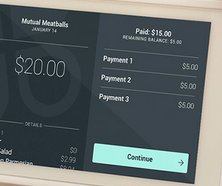Mobile Payments and Microchip Credit Cards
Today’s consumer doesn’t always carry a wallet. However, he or she definitely carries a smartphone. And technology has become so advanced that people can now use an app on their mobile device to pay for goods and services.
Credit cards are becoming “smarter” too. Advances in microchips mean that customers no longer need to insert their credit cards into a terminal. Instead, they can simply tap them against the machine to complete the transaction.
How do these changes affect vendors? Read on to learn more.
Mobile Wallets: The Payment Technology of the Future?
When customers pay through their smartphone, that’s known as using a “mobile wallet.” A mobile wallet is a digital container that stores electronic payment information so that consumers can carry out transactions.
How popular are mobile wallets? The market research firm eMarketer predicted in October 2015 that by the end of that year, mobile payments would total $8.71 billion in the US alone. By the next year, that figure will grow to $27.05 billion.
The numbers shouldn’t come as a surprise. Paying with a mobile wallet offers an unprecedented level of convenience and ease – all shoppers have to do is take out their smartphone and tap it against a terminal. A number of companies have taken advantage of the enormous opportunity mobile wallets represent. Apple, Google, Samsung all offer mobile wallets, and as more consumers adopt the technology, there will undoubtedly be more entrants into the market.
Near Field Communication: The Secret to Contactless Payments
Mobile wallets and credit cards that you can tap against a terminal run on technology known as near field communication (NFC).
NFC is a wireless data transfer method. It enables objects to transmit information without an internet connection. We’ll illustrate how it works with an example. Samantha goes to her local grocery store. When she gets to the checkout line, she pulls out her Visa card. She taps her credit card against the terminal, and the card’s microchip sends Samantha’s payment information to the microchip inside the terminal.
Now, let’s say Samantha was using Apple Pay instead of her Visa card. She would do the exact same thing at the register, except she would tap her phone against the terminal instead of her Visa. The microchip in her phone would communicate in exactly the same way as her Visa card would. And the result is the same, too: Samantha still pays for her groceries.
NFC technology works at a very close range. The maximum distance at which you can use an NFC-enabled device or credit card is four centimeters (a little over an inch and a half). So, it’s virtually impossible to accidentally carry out a transaction.
MBankcard Payment Processors: Helping You Accept Tomorrow’s Payment Technology, Today
Do you want to accept mobile payments and microchip-enabled credit cards? MBankcard offers the latest credit card readers at a low cost so you can satisfy your customers’ payment preferences. Call us today at Contact Us to learn more.






